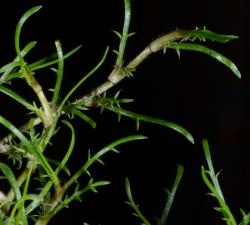- Taxon
- Gallery
- ≡ Cotula maniototo Petrie, Trans. & Proc. New Zealand Inst. 14: 339-340 (1882)
A very small perennial (occ. annual) herb forming loose patches or an inconspicuous low matted turf. Rhizomes at or near soil surface, slender, less than 1 mm diam., often hidden within leaves, ± villous, becoming wiry and glabrous when older; branches often difficult to discern, poorly differentiated from short shoots; leaves crowded in two rows, ± horizontal, up to 10 clustered at the apex, imbricate or older ones gradually becoming up to 4 mm apart; short shoots at most nodes, initially with a few reduced leaves in the axils of rhizome leaves, often converted into rhizomes with distant leaves. Roots abundant, slender, up to 0.5 mm diam., white. Leaves variable, 0.2-2.5 cm long; blade up to 2.0 cm long, either 1-pinnatifid, lanceolate or oblong and up to 2 mm wide or (especially in winter) simple, linear and ca. 0.5 mm wide, thin, grass-green and glabrous to silky white and densely villous; midrib not raised on ventral surface; pinnae 0 or 1-2 minute lobes or up to 6 pairs, distant, subequal, shorter than the terminal lobe, linear, narrower than the rhachis, without teeth. Peduncles very short, less than 1 mm long, nude. Monoecious. Heads almost sessile, small, 2-3 mm diam.; surface convex; involucre campanulate; phyllaries ca. 10 in 1-2 subequal rows, oblong, rather thin, green villous, with wide brown or reddish scarious margin, not growing after anthesis; pistillate florets 15-20 in 1-2 rows, ca. 2.0 mm long, straight, pale yellow and red-tipped; corolla four times as long as wide, with equal teeth; staminate florets ca. equal in number. Achenes up to 1.0 × 0.3 mm, slightly compressed, biconvex, green turning chocolate brown, unwrinkled and soft. Flowers in summer.
[Reproduced from Lloyd (1972, New Zealand J. Bot. 10: 277–372, as Cotula maniototo Petrie) with permission from The Royal Society of New Zealand.]




